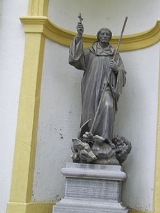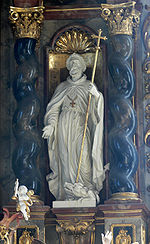
Magnus of Füssen
Encyclopedia
Saint Magnus of Füssen, otherwise Magnoald or Mang, was a missionary saint in southern Germany
, also known as the Apostle of the Allgäu
. He is believed to have been a contemporary either of Saint Gall
(d. 627) or of Saint Boniface
(d. 754) and is venerated as the founder of St. Mang's Abbey, Füssen
.
, spent some time with Willimar, a priest at Arbon
. Here Gall fell sick and was put in charge of Magnus and Theodore (Magnoald and Theodo), two clerics living with Willimar, while Columbanus proceeded to Italy and founded Bobbio Abbey
. When Gall had been miraculously informed of the death of Columbanus he sent Magnus to pray at his grave in Bobbio. Magnus returned with the staff of Columbanus and thereafter they followed his rule. After the death of Gall, Magnus succeeded him as superior of the cell.
About this time a priest of the Diocese of Augsburg, named Tozzo or Toto, came as a pilgrim to the grave of Saint Gall and invited Magnus to accompany him to the eastern part of the Allgäu. Magnus proceeded to Eptaticus (Epfach), where Wichbert, Bishop of Augsburg
received him and entrusted him with the Christianization of the eastern Algäu. He penetrated into the wilderness, then crossed the Lech River
at a place still known as St. Mangstritt ("footstep of Saint Magnus") and built a cell, where afterwards the monastery of Füssen
was erected, and where he died.He was buried in the church he had constructed. In 851 he was reburied in the newly erected church. One of his bones was sent to St Gallen in Switzerland.Around the year 1100 all his bones were found to be missing. The burial place can be seen in the crypt of St Mang Basilica, Füssen. A tiny splinter of the breast bone was sent from St Gallen to Füssen and this is now located in a large glass cross hanging above the main altar. It also contains the staff, cross and chalice of the saint.
 The "Life" is said to have been written by Theodore, the companion of Magnus, under whose head it was placed in the grave. When in 851 Bishop Lanto transferred the relics to the newly erected church of Füssen, this "Life" is said to have been found in a scarcely legible condition, and to have been emended and re-written by Ermenrich, a monk of Ellwangen
The "Life" is said to have been written by Theodore, the companion of Magnus, under whose head it was placed in the grave. When in 851 Bishop Lanto transferred the relics to the newly erected church of Füssen, this "Life" is said to have been found in a scarcely legible condition, and to have been emended and re-written by Ermenrich, a monk of Ellwangen
. It was re-edited with worthless additions in 1070 by Otloh of St. Emmeram
. A manuscript is preserved at the Abbey of St. Gall
(Codex 565).
The chief inconsistencies in the "Life" are the following: Magnus is made a disciple of Saint Gall (d. 627) and at the same time he is treated as a contemporary of Wichbert, the first historically established bishop of Augsburg
(d. about 749). Other manifest impossibilities have induced Mabillon and other authorities to reject the whole "Life" as a forgery of a much later date. Another school of thought however is that the second part of the "Life" was written in 851 in Ellwangen (although probably not by Ermenrich) when the relics of the saint were transferred there, while the first part, where Magnus is made a companion of Saint Gall, is a later addition, which may incorporate the remains of the story of an earlier saint also called Magnus. This second view seems to have attracted greater support. The cult of Saint Magnus of Cuneo may have arisen as a result of the expansion of Magnus of Füssen’s cult into Italy
, with Magnus of Cuneo mistakenly being considered a separate saint.
His feast is celebrated on 6 September.
Germany
Germany , officially the Federal Republic of Germany , is a federal parliamentary republic in Europe. The country consists of 16 states while the capital and largest city is Berlin. Germany covers an area of 357,021 km2 and has a largely temperate seasonal climate...
, also known as the Apostle of the Allgäu
Allgäu
The Allgäu is a southern German region in Swabia. It covers the south of Bavarian Swabia and southeastern Baden-Württemberg. The region stretches from the prealpine lands up to the Alps...
. He is believed to have been a contemporary either of Saint Gall
Saint Gall
Saint Gall, Gallen, or Gallus was an Irish disciple and one of the traditionally twelve companions of Saint Columbanus on his mission from Ireland to the continent. Saint Deicolus is called an older brother of Gall.-Biography:...
(d. 627) or of Saint Boniface
Saint Boniface
Saint Boniface , the Apostle of the Germans, born Winfrid, Wynfrith, or Wynfryth in the kingdom of Wessex, probably at Crediton , was a missionary who propagated Christianity in the Frankish Empire during the 8th century. He is the patron saint of Germany and the first archbishop of Mainz...
(d. 754) and is venerated as the founder of St. Mang's Abbey, Füssen
St. Mang's Abbey, Füssen
St. Mang's Abbey, Füssen or Füssen Abbey was a Benedictine monastery in Füssen in Bavaria, Germany.- History :The Benedictine abbey of Saint Mang was founded in the first half of the 9th century as a proprietary monastery of the Bishops of Augsburg...
.
Life
There is almost no reliable information about him. The only source is an old "Vita S. Magni", which however contains so many obvious anachronisms that little reliance can be placed on it. It relates that the two Irish missionaries Saints Columbanus and GallSaint Gall
Saint Gall, Gallen, or Gallus was an Irish disciple and one of the traditionally twelve companions of Saint Columbanus on his mission from Ireland to the continent. Saint Deicolus is called an older brother of Gall.-Biography:...
, spent some time with Willimar, a priest at Arbon
Arbon, Switzerland
Arbon is a municipality and district capital of the district of Arbon in the canton of Thurgau in Switzerland.-Geography:Arbon is situated on a peninsula on the southwest shore of Lake Constance between Romanshorn and Rorschach. On the south, the municipality borders the canton of St. Gallen. St...
. Here Gall fell sick and was put in charge of Magnus and Theodore (Magnoald and Theodo), two clerics living with Willimar, while Columbanus proceeded to Italy and founded Bobbio Abbey
Bobbio Abbey
Bobbio Abbey is a monastery founded by Irish Saint Columbanus in 614, around which later grew up the town of Bobbio, in the province of Piacenza, Emilia-Romagna, Italy. It is dedicated to Saint Columbanus...
. When Gall had been miraculously informed of the death of Columbanus he sent Magnus to pray at his grave in Bobbio. Magnus returned with the staff of Columbanus and thereafter they followed his rule. After the death of Gall, Magnus succeeded him as superior of the cell.
About this time a priest of the Diocese of Augsburg, named Tozzo or Toto, came as a pilgrim to the grave of Saint Gall and invited Magnus to accompany him to the eastern part of the Allgäu. Magnus proceeded to Eptaticus (Epfach), where Wichbert, Bishop of Augsburg
Bishop of Augsburg
The Bishop of Augsburg is the Ordinary of the Roman Catholic Diocese of Augsburg in the Ecclesiastical province of München und Freising.The diocese covers an area of 13,250 km².The current bishop is Konrad Zdarsa who was appointed in 2010....
received him and entrusted him with the Christianization of the eastern Algäu. He penetrated into the wilderness, then crossed the Lech River
Lech River
The Lech is a river in Austria and Germany. It is a right tributary of the Danube in length with a drainage basin of .Its source is located in the Austrian state of Vorarlberg, where the river rises from lake Formarinsee in the Alps at an altitude of...
at a place still known as St. Mangstritt ("footstep of Saint Magnus") and built a cell, where afterwards the monastery of Füssen
St. Mang's Abbey, Füssen
St. Mang's Abbey, Füssen or Füssen Abbey was a Benedictine monastery in Füssen in Bavaria, Germany.- History :The Benedictine abbey of Saint Mang was founded in the first half of the 9th century as a proprietary monastery of the Bishops of Augsburg...
was erected, and where he died.He was buried in the church he had constructed. In 851 he was reburied in the newly erected church. One of his bones was sent to St Gallen in Switzerland.Around the year 1100 all his bones were found to be missing. The burial place can be seen in the crypt of St Mang Basilica, Füssen. A tiny splinter of the breast bone was sent from St Gallen to Füssen and this is now located in a large glass cross hanging above the main altar. It also contains the staff, cross and chalice of the saint.

Ellwangen Abbey
Ellwangen Abbey was the earliest Benedictine monastery established in the Duchy of Swabia, at the present-day town of Ellwangen an der Jagst, Baden-Württemberg about 100 km north-east of Stuttgart.-Imperial abbey:...
. It was re-edited with worthless additions in 1070 by Otloh of St. Emmeram
Otloh of St. Emmeram
Otloh of St Emmeram was a Benedictine monk of St Emmeram's in Regensburg, known as a scholar and educator.-Life:...
. A manuscript is preserved at the Abbey of St. Gall
Abbey of St. Gall
The Abbey of Saint Gall is a religious complex in the city of St. Gallen in present-day Switzerland. The Carolingian-era Abbey has existed since 719 and became an independent principality during the 13th century, and was for many centuries one of the chief Benedictine abbeys in Europe. It was...
(Codex 565).
The chief inconsistencies in the "Life" are the following: Magnus is made a disciple of Saint Gall (d. 627) and at the same time he is treated as a contemporary of Wichbert, the first historically established bishop of Augsburg
Bishop of Augsburg
The Bishop of Augsburg is the Ordinary of the Roman Catholic Diocese of Augsburg in the Ecclesiastical province of München und Freising.The diocese covers an area of 13,250 km².The current bishop is Konrad Zdarsa who was appointed in 2010....
(d. about 749). Other manifest impossibilities have induced Mabillon and other authorities to reject the whole "Life" as a forgery of a much later date. Another school of thought however is that the second part of the "Life" was written in 851 in Ellwangen (although probably not by Ermenrich) when the relics of the saint were transferred there, while the first part, where Magnus is made a companion of Saint Gall, is a later addition, which may incorporate the remains of the story of an earlier saint also called Magnus. This second view seems to have attracted greater support. The cult of Saint Magnus of Cuneo may have arisen as a result of the expansion of Magnus of Füssen’s cult into Italy
Italy
Italy , officially the Italian Republic languages]] under the European Charter for Regional or Minority Languages. In each of these, Italy's official name is as follows:;;;;;;;;), is a unitary parliamentary republic in South-Central Europe. To the north it borders France, Switzerland, Austria and...
, with Magnus of Cuneo mistakenly being considered a separate saint.
His feast is celebrated on 6 September.

